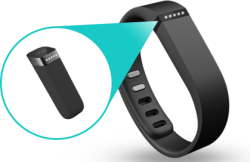FitBit - ‘cause you can't improve what you don’t measure
November 11, 2013I recently blogged about the importance of walking and thus the need for keeping track of your daily step count using a pedometer. I also mentioned that my tools of choice for this purpose is the FitBit device series.
Again: I am not affiliated with FitBit in any way. I just really like their products and think they do an awesome job when it comes to self fitness assessment and quantification.
The Flex
That’s the device I personally use. It consists of a rubber armband (available in different colors and sizes) and the actual bit, which sits inside the armband and can be taken out for recharging. This is usually necessary once a week, which is acceptable in my opinion.
It also comes with a wireless Bluetooth receiver that synchronizes your activity as soon as it comes within a range of 4 - 5 meters (15 ft.). This has worked extremely reliably for me and not once let me down yet. With some smart phones, the Flex can even sync its data directly over Bluetooth 4.0. I was looking forward to this feature with my new Nexus 5 phone but unfortunately there are some issues and it has been disabled for now.
Another useful feature of the Flex are its silent alarms. These can be configured trough the FitBit web site or the available apps and then Flex then wakes you up using a very unobtrusive vibration alarm.
Side Note: Silent Alarms are a great idea if you want to go for a run or hit the gym at 6 AM and not want to wake your wife or kid. They will appreciate it - believe me.
The Zip
The Zip comes in the classical pedometer form factor and can be clipped to your belt or just kept in your pocket. Is also comes in a couple of different colors.
It uses the same Bluetooth receiver as the Flex, which is very handy so we can sync both our devices through our home server, which is always on.
My wife prefers this device for a couple of reasons:
- First, she simply likes this form factor better than the wrist band - fair enough.
- The current step count, walking distance and calorie consumption are always visible on its LCD display, which is admittedly a nice advantage over the Flex.
- Here the biggest pro: it’s battery life is way out of the Flex’s league. It comes with a coin cell battery which we haven’t had to change yet even though it’s always on and used daily for about 4 months now.
The data you get out of the device is the same as for the Flex and also the apps and web site dashboards are identical. This is cool if you want to compare your data, which we do heavily. By now, my wife and I have become pretty competitive over who hits their daily step goal first or who wins a day / week / month in terms of steps and distance. Great fun!
The Aria
As a complementary device to the pedometers we also got the Aria WIFI scale. Since it’s also a device of the FitBit product line, it integrates is data perfectly into the existing apps, which is pretty useful. Since it’s a WIFI scale it automatically uploads its measured data to the previously linked FitBit accounts. Very useful!
The Aria measures not only your weight but also your body fat percentage. Like all body fat scales the Aria will not give you an accurate body fat value but still it results are consistent and this data can be used for trend analysis, which is actually useful.
Here’s an algorithm of how to include your body fat scale into your workout / dieting routine:
The Force
This is a device which was recently launched as starts shipping right now in the US (in Europe it will become available only next year). It has a similar form factor than the Flex but comes with a permanent display like the Zip, combining the best of both worlds.
I am very much looking forward to the day the Force will be with me :D and do do another review on it or extend this blog post.



